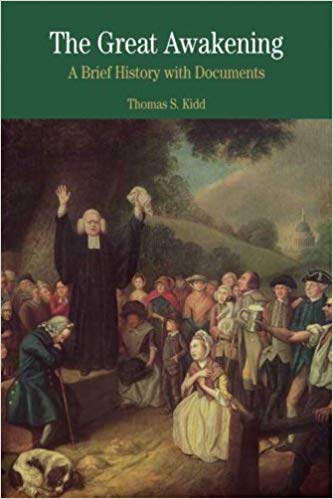A Book Review from Books At a Glance
By Gary Steward
Thomas Kidd calls the Great Awakening “the most significant religious and cultural upheaval in the history of colonial America” (vii). As such, this subject merits the attention of all who have an interest in American cultural, religious, and political history. Kidd has written more than one work on the Great Awakening. His biography of George Whitefield (Yale, 2016) covers it, and his larger work on the subject, The Great Awakening: The Roots of Evangelical Christianity in Colonial America (Yale, 2009), surveys the history of the Great Awakening from a variety of perspectives and in significant detail. This shorter volume published by Bedford/St. Martin’s is a part of the Bedford Series in History and Culture. This series packages primary source materials into shorter books that might function well for supplemental use in undergraduate history classes, bringing students into direct content with a variety of source materials surrounding particular events.
In the first twenty-seven pages, Kidd provides an overview of the Great Awakening, surveying the history, perspectives, controversies, and results of the awakening. This brief narrative provides the context for each of the primary source readings which make up the bulk of the book. Kidd concludes this introductory overview by surveying the debate among historians as to the awakening’s role in spurring on the American Revolution. While Kidd maintains that “the connections between the Great Awakening and the Revolution remain indeterminate” (24), he sees a greater connection between the Great Awakening and contemporary American evangelicalism. In his mind, “to study the First Great Awakening us to examine the early history of a movement [i.e., American evangelicalism] that continues to have a great deal of contemporary relevance” (26).
The primary source readings open with excerpts from Jonathan Edwards’s 1737 Faithful Narrative and Timothy Cutler’s assertion that the Northampton revival was merely an instance of religious fanaticism. The second selection contains an excerpt from George Whitefield’s Journals and various responses to Whitefield, including Anglican Stephen Bordley’s critique of Whitefield and Presbyterian Josiah Smith’s defense of Whitefield’s ministry and character. After an excerpt from Gilbert Tennent’s controversial sermon, The Danger of an Unconverted Ministry (1740), the third section includes nine different conversion narratives, many from lesser known individuals. The fourth section contains excerpts that illustrate the controversial nature of the revival and the attempt by different individuals to discern between a true work of God’s Spirit and mere emotionalism and fanaticism. The accounts of Jonathan Edwards, James Davenport, and presumably Charles Chauncy all feature prominently in this section. The fifth section contains sources that show the spread of evangelical fervor into Virginia and the South from the 1740s to the early 1770s. The final section addresses the growth of separatists and Baptists in New England from the Great Awakening, and the subsequent fight for religious liberty by individuals such as Isaac Backus and John Leland.
This short book is well-suited for students and individuals wanting to explore the different facets of the Great Awakening. The book closes with a chronology of the Great Awakening, questions that can be used for further discussion or analysis of the sources, a selected bibliography, and an index. This book makes an excellent companion to Kidd’s larger work on the subject. The unique value of this book is the wide variety of primary sources excerpt and presented in such a brief book. Students of history especially need books like this to help get them into primary source reflection and study of first-hand accounts.
Dr. Gary Steward
Assistant Professor of History and Chair of the Department of Social Sciences
Colorado Christian University
